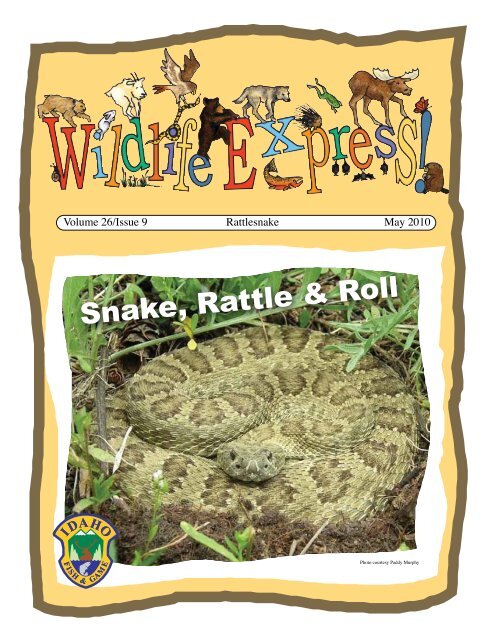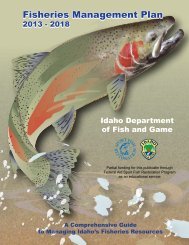May 2010 - Idaho Fish and Game
May 2010 - Idaho Fish and Game
May 2010 - Idaho Fish and Game
You also want an ePaper? Increase the reach of your titles
YUMPU automatically turns print PDFs into web optimized ePapers that Google loves.
Volume 26/Issue 9 Rattlesnake <strong>May</strong> <strong>2010</strong><br />
IDAHO<br />
IDAHO<br />
IS IS HH FF &&<br />
Snake, Rattle & Roll<br />
GAM<br />
GAM EE<br />
Photo courtesy Paddy Murphy
Let’s Talk About . . . ATTLESNAKES<br />
What goes through your mind<br />
when you hear someone yell,<br />
“Rattlesnake!” Do you get<br />
nervous or scared? Or do you<br />
think, “Cool, snake!” Many<br />
people have mixed feelings<br />
about snakes, especially<br />
rattlesnakes. Often rattlesnakes<br />
are misunderstood.<br />
Rattlesnakes are found<br />
everywhere in <strong>Idaho</strong> except the<br />
northern part of the state <strong>and</strong><br />
high in the mountains. You may<br />
have heard one while taking a<br />
hike. When rattlesnakes feel<br />
threatened, they shake the rattle<br />
on the end of their tails <strong>and</strong><br />
make a sound. The twitches<br />
can be 20 to 100 times per<br />
second! The warmer a snake is<br />
the faster it can shake its tail.<br />
They can sound a bit scary,<br />
but <strong>Idaho</strong>’s rattlesnakes are<br />
calm snakes. They rarely rattle.<br />
Even when approached, they<br />
usually remain calm <strong>and</strong> still.<br />
They would rather avoid being<br />
seen or heard.<br />
The rattle is made of interlocking<br />
rings of keratin. Your<br />
fingernails are made of keratin.<br />
Every time a snake sheds its<br />
skin a ring is added to the<br />
rattle. Snakes shed their skin<br />
when they grow. A rattlesnake<br />
may shed its skin up to four<br />
times a year, so you can’t tell a<br />
rattlesnake’s age by the number<br />
of rattles it has on its tail.<br />
The Western Rattlesnake<br />
Rattlesnakes are not the<br />
longest snake in <strong>Idaho</strong>, but they<br />
are the beefiest. They can reach<br />
a length of around five feet, <strong>and</strong><br />
their bodies are bigger around<br />
than <strong>Idaho</strong>’s other snakes.<br />
Western rattlesnakes come<br />
in many colors. They may be<br />
brown, tan, gray or olive green<br />
with brown or black patches.<br />
Their bellies are usually cream<br />
or yellow colored.<br />
Rattlesnakes are the only<br />
dangerous snake in <strong>Idaho</strong>. They<br />
use venom to kill their prey.<br />
Rattlesnakes eat mostly mice,<br />
ground squirrels <strong>and</strong> small<br />
rabbits, but they may also eat<br />
lizards or birds. Rattlesnakes<br />
have good senses to find their<br />
prey. They use their forked<br />
tongue to pick up a prey’s<br />
scent. They flick their tongue<br />
out, pick up smells <strong>and</strong> then<br />
pass the tongue over a special<br />
organ on the roof of the mouth<br />
called the Jacobson’s organ.<br />
This helps the snake to smell<br />
its prey, but rattlesnakes have<br />
something else that helps them<br />
find prey. They have two heatsensitive<br />
pits on their heads<br />
between the nose <strong>and</strong> mouth.<br />
These pits let the snake “see”<br />
their prey in total darkness.<br />
A rattlesnake can sense prey<br />
that is 1/10 of a degree warmer<br />
than its surroundings! When a<br />
rattlesnake senses prey, it grabs<br />
the prey by the mouth. It has<br />
long, hollow fangs that it uses<br />
to inject venom in the prey.<br />
The fangs are folded up against<br />
the roof of the mouth when the<br />
mouth is closed. When striking,<br />
the fangs swing down to inject<br />
the venom.<br />
Rattlesnakes are one of the<br />
few snakes that give birth to<br />
their young. Three to 12 young<br />
are born between August <strong>and</strong><br />
October. The young rattlesnakes<br />
are born without a rattle.<br />
When they are one to two<br />
weeks old, they shed their skin<br />
for the first time. This is when<br />
the rattle gets its first ring.<br />
Rattlesnakes are fascinating.<br />
Watch for them during the<br />
day during the spring <strong>and</strong> cool<br />
summer days. They are active<br />
at night during the hot summer<br />
months.<br />
Photo Courtesy Evin Oneale
Photo courtesy Scott Farnsworth<br />
What is a Reptile?<br />
When you think of a reptile, you may think of<br />
a snake or lizard. <strong>May</strong>be a turtle pops into your<br />
mind. People often think of reptiles as scaly,<br />
cold-blooded animals that usually lay eggs.<br />
Some scientists that group, or classify, animals<br />
are starting to look at reptiles a bit differently.<br />
Some divide reptiles into four groups. The first<br />
group includes turtles. The second group is lizards<br />
<strong>and</strong> snakes, <strong>and</strong> the third group is crocodiles<br />
<strong>and</strong> their relatives. The last group is the birds!<br />
Scientists put birds in this group because bird<br />
skulls <strong>and</strong> eggs are so similar to reptiles. These<br />
scientists believe the similarities between bird<br />
skulls <strong>and</strong> eggs <strong>and</strong> reptile skulls <strong>and</strong> eggs are<br />
more important than the differences between the<br />
two. They are not as concerned about the fact that<br />
birds are warm-blooded, <strong>and</strong> all other reptiles are<br />
cold-blooded.<br />
Believe it or not, when we look at the cells of<br />
crocodiles, birds, <strong>and</strong> lizards, crocodiles actually<br />
have more in common with birds than they do with<br />
lizards. You may be wondering about the feathers<br />
on birds. They don’t look much like scales, but<br />
they really are scales that have changed over time<br />
to help birds fly.<br />
If we leave birds out of the reptile group, reptiles<br />
are found on every continent except Antarctica.<br />
Most reptiles have a hard time staying warm. They<br />
can’t make heat inside their bodies, so Antarctica<br />
would just be a giant freezer <strong>and</strong> graveyard for<br />
them. It is too cold! Since <strong>Idaho</strong> has pretty cold<br />
winters, we don’t have as many reptiles as some<br />
other states. We have one turtle, 10 lizards <strong>and</strong> 11<br />
snakes.<br />
Reptiles have been on the Earth for a long time.<br />
About 250 million years ago, the first reptiles<br />
appeared. They ruled the planet for 200 million<br />
years. All of our birds <strong>and</strong> mammals have reptiles<br />
as their ancestors. I bet you can guess who their<br />
ancestors are. They were the largest l<strong>and</strong><br />
animals ever - dinosaurs!<br />
Reptiles come in all shapes <strong>and</strong> sizes.<br />
They can be really big. Saltwater<br />
crocodiles can grow to be over 23 feet<br />
long. Other reptiles are small. A gecko<br />
that lives on the British Virgin Isl<strong>and</strong>s is<br />
less than an inch long! Reptiles may come<br />
in different shapes <strong>and</strong> sizes, but they are all<br />
interesting creatures!
Have you ever heard of herpetology (her-pe-<br />
TOL-e-jee)? In Greek, herp means creeping, so<br />
herpetology is the study of creeping things. It is<br />
the study of reptiles <strong>and</strong> amphibians. Many people<br />
just call them “herps” for short.<br />
Amphibians <strong>and</strong> reptiles may look a bit alike<br />
<strong>and</strong> share a few things in common. They are both<br />
cold-blooded, most have legs <strong>and</strong> most lay eggs.<br />
But they really are quite different. Let’s look at<br />
some of the differences.<br />
Amphibians have a thin, moist skin. Reptiles<br />
have a tough, thick skin covered with scales.<br />
Amphibians have different stages in their develop-<br />
ment – egg, larvae (LAR-vee) <strong>and</strong> adult. They<br />
go through a metamorphosis. Reptiles do not go<br />
through this sort of change. Amphibians need a<br />
wet place to lay their eggs. Reptiles lay their eggs<br />
in dry places.<br />
What’s Herpetology?<br />
With so many many differences, differences, how did did amphibians<br />
<strong>and</strong> <strong>and</strong> reptiles get grouped together? They were<br />
grouped grouped together together before before people people knew knew much much<br />
about them. With modern science, people<br />
know a lot more about animals then<br />
they did in the past. Scientists can<br />
look inside cells <strong>and</strong> see how animals<br />
are put put together. As we learn more <strong>and</strong><br />
more about animals, we we may discover<br />
other ways amphibians <strong>and</strong> <strong>and</strong> reptiles are are<br />
different from or similar to each other.<br />
If you want to go “herping” <strong>and</strong> look for reptiles<br />
or amphibians, here are some things to keep in<br />
mind. Herps can bite! Use a net <strong>and</strong> wear thick<br />
leather gloves when h<strong>and</strong>ling animals <strong>and</strong> NEVER<br />
h<strong>and</strong>le a rattlesnake. Herps are most active during<br />
the spring breeding season, so this is the time<br />
you will be most likely to see them. Never reach<br />
under a rock or log with your bare h<strong>and</strong>s. Use a<br />
good sturdy stick to flip things over. Many herps<br />
hide under rocks, logs <strong>and</strong> leaves, so looking<br />
under things is a good place to start. Look for<br />
amphibians at night <strong>and</strong> reptiles during the day.<br />
If you would like to get a close look at an<br />
amphibian or reptile, place the animal in a clear<br />
plastic box. Amphibians will need a bit of water in<br />
the box. Once you are done looking at your herp,<br />
put it back where you found it. Although it may<br />
seem fun to keep herps as pets, it can be tricky<br />
keeping them alive. Wild animals belong in the<br />
wild.<br />
Photo Courtesy Evin Oneale
Warm-blooded<br />
Warm-blooded animals have body temperatures<br />
that don’t change with the weather. Their<br />
temperatures stay about the same in cold weather<br />
<strong>and</strong> in hot weather. Mammals <strong>and</strong> birds are warm-<br />
blooded.<br />
Warm-blooded animals can make heat if they are<br />
cold, <strong>and</strong> cool themselves if they are hot. To make<br />
heat, warm-blooded animals turn the food they<br />
eat into energy. Only a small amount of the food<br />
warm-blooded animals eat is turned into muscle.<br />
The rest is used to keep its body temperature even.<br />
Some animals shiver to help keep their bodies<br />
warm. You may also hear people call warm-<br />
blooded animals endothermic (en-do-THER-mik).<br />
Endo means inside, <strong>and</strong> therm means heat. So, an<br />
endothermic animal makes heat inside its body.<br />
To keep cool, endotherms sweat, pant or move<br />
to a cool place. Only mammals can sweat. People<br />
<strong>and</strong> monkeys have sweat gl<strong>and</strong>s all over their<br />
bodies. Dogs <strong>and</strong> cats only have sweat gl<strong>and</strong>s on<br />
their feet, so they need to pant if they get too hot.<br />
As long as they can find enough food, warm-<br />
blooded animals can be found in almost any<br />
habitat on Earth. They can be found in arctic<br />
regions, hot tropical areas <strong>and</strong> even swimming in<br />
the oceans!<br />
Photo courtesy Colin Howe<br />
Cold-blooded<br />
Cold-blooded animals really don’t have cold<br />
blood. It means they are the same temperature<br />
as their surroundings. If a lizard is sitting on<br />
s<strong>and</strong> that is 60 degrees, the lizard will also be<br />
60 degrees. Lizards, turtles, insects, snakes,<br />
fish <strong>and</strong> frogs are cold-blooded animals.<br />
Some people call cold-blooded animals<br />
ectothermic (ek-to-THER-mik). Ecto means<br />
outside, <strong>and</strong> therm means heat. Ectothermic<br />
animals get heat from outside their bodies. You<br />
may also hear people call them poikilotherms<br />
(poy-KEE-lo-therms). This is just a fancy word<br />
for a cold-blooded animal.<br />
Cold-blooded animals are most active in<br />
warm weather. Cold weather slows down their<br />
muscles. That’s why cold-blooded animals<br />
lay or bask in the sun. The sun helps to warm<br />
them up. If they get too warm, they need to<br />
move to a shady spot or go in a burrow. Colder<br />
weather can kill cold-blooded animals. They<br />
need to migrate to warmer places or move<br />
underground. Some cold-blooded animals, like<br />
bees <strong>and</strong> dragonflies, shiver to stay warm.<br />
Cold-blooded animals have a real advantage<br />
in deserts. Deserts are warmer, <strong>and</strong> food is<br />
often harder to find. Cold-blooded animals<br />
don’t need to eat as much as warm-blooded<br />
animals. Sometimes they can go months<br />
between meals. This is why you often see more<br />
cold-blooded animals living in deserts than<br />
warm-blooded animals.
Oooouuuuch!<br />
Many animals use<br />
venom for protection or<br />
as a way to capture prey.<br />
Ants, bees, lizards <strong>and</strong><br />
snakes are just some of<br />
the animals that may<br />
use venom. Venoms are<br />
chemicals that have toxic<br />
effects in the bodies of<br />
other animals.<br />
If you have even been<br />
stung by a wasp, you<br />
have experienced one<br />
effect of venom – pain!<br />
Wasps, bees <strong>and</strong> the<br />
Gila monster lizard<br />
have venoms that cause<br />
sudden <strong>and</strong> strong pain.<br />
These venoms are used<br />
mainly for protection.<br />
Once an animal has<br />
experienced the sting of a<br />
bee, it usually will think<br />
twice before messing<br />
with bees again!<br />
Snakes make venoms<br />
that are used mainly<br />
to capture prey. These<br />
venoms will either<br />
paralyze muscles or<br />
cause bleeding to destroy<br />
muscles. Snake venoms<br />
also have a bit of a<br />
digestive function. They<br />
start to break down the<br />
prey so it will be easier<br />
to eat, but this is not as<br />
important as making<br />
sure the prey cannot run<br />
away. Pit vipers, like<br />
our rattlesnake, have the<br />
most complex venoms of<br />
any snakes. Their venom<br />
will paralyze <strong>and</strong><br />
destroy muscles.<br />
The snakes with<br />
the deadliest venoms<br />
are sea snakes. Their<br />
venom would instantly<br />
kill a human. Luckily<br />
for us, sea snakes are<br />
not aggressive snakes<br />
<strong>and</strong> rarely bite humans.<br />
Sometimes a snake<br />
will bite <strong>and</strong> not inject<br />
venom. Snakes can <strong>and</strong><br />
do control the amount of<br />
venom that is released<br />
during a bite.<br />
Most snakes are not<br />
aggressive. Many people<br />
are bitten because they<br />
were h<strong>and</strong>ling a snake.<br />
If you or someone you<br />
know is bitten by a<br />
venomous snake, stay<br />
calm. This will help to<br />
slow how quickly the<br />
venom spreads. Don’t try<br />
to cut the wound or suck<br />
the venom out with your<br />
mouth. This will cause<br />
more damage. The best<br />
thing to do is wash the<br />
bite with soap <strong>and</strong> water<br />
<strong>and</strong> get to a hospital<br />
as soon as possible.<br />
A hospital will have<br />
antivenin. Antivenin will<br />
help to stop the affects of<br />
the venom.<br />
The best way to avoid<br />
a snake bite is to avoid<br />
snakes! When you are<br />
outside, watch where you<br />
step <strong>and</strong> put your h<strong>and</strong>s.<br />
Remember snakes are<br />
not aggressive. Leave<br />
them alone <strong>and</strong> they will<br />
be more than happy to do<br />
the same for you.<br />
Be Outside,<br />
It’s Summer!<br />
It’s <strong>May</strong> <strong>and</strong> school is almost out. How are<br />
you going to spend your summer? Why not plan<br />
to spend a lot of your summer outside? Put on<br />
some sunscreen, grab your water bottle <strong>and</strong> head<br />
outdoors! <strong>Idaho</strong> has great places to explore both<br />
in your own backyard <strong>and</strong> neighborhood as well<br />
as forests, parks, <strong>and</strong> wilderness. Get your family<br />
or friends <strong>and</strong> plan some fun outdoor activities.<br />
Time outside will help you stay healthy <strong>and</strong><br />
relaxed plus help you become more creative <strong>and</strong><br />
observant. Here are a few ideas for summer fun:<br />
Go fishing<br />
Take a hike<br />
Go camping<br />
Paddle a canoe<br />
Ride your bike<br />
Build a s<strong>and</strong> castle<br />
Go swimming<br />
Stay up late <strong>and</strong> look the stars<br />
Plant a garden<br />
or a flower bed<br />
Draw with sidewalk chalk<br />
Build a fort<br />
Play in the sprinkler<br />
Watch bugs<br />
Read a book outside<br />
Lie on your back <strong>and</strong> watch the clouds<br />
Get up early <strong>and</strong> watch the sunrise<br />
Keep an outdoor journal<br />
Climb a tree<br />
Play kick-the-can with your friends<br />
Draw or paint outside<br />
Go bird watching<br />
Be an outdoor photographer<br />
Ride your scooter<br />
Visit a nature center<br />
Go on a night hike<br />
Roast marshmallows over a campfire<br />
Keep a summer wildlife list<br />
Have a picnic<br />
Go berry-picking<br />
Play marbles<br />
For more ideas check out www.beoutsideidaho.<br />
org. Have a great summer!
Photo courtesy Scott Farnsworth<br />
Is it a<br />
Rattlesnake?<br />
All of <strong>Idaho</strong>’s snakes use a form of camouflage to<br />
help them disappear against rocks <strong>and</strong> soil. One of<br />
<strong>Idaho</strong>’s snakes also uses something else for protection.<br />
It pretends to be a rattlesnake! This trickster is the<br />
gopher snake – sometimes called the bull snake.<br />
Gopher snakes use a special kind of camouflage<br />
called mimicry (mim-ik-ree). Mimicry is when an<br />
animal looks like or acts like another animal. Not very<br />
many animals want to mess with rattlesnakes. Their<br />
bite could mean death! Pretending to be a rattlesnake<br />
is a great way for gopher snakes to protect themselves<br />
when they feel threatened. They coil up, hiss <strong>and</strong><br />
shake their tails. When the tail hits dry leaves or<br />
grass, it sounds like a rattlesnake! Pretending to be a<br />
rattlesnake may scare away predators, but there can<br />
be a down side. Unfortunately, sometimes humans kill<br />
gopher snakes thinking they are rattlesnakes. How do<br />
you tell them apart?<br />
First, grab some binoculars – getting too close is<br />
NOT a good idea. Gopher snakes’ colors are similar<br />
to rattlesnakes, <strong>and</strong> they live in the same habitats.<br />
So color or location is not the way to tell them apart.<br />
Gopher snakes are <strong>Idaho</strong>’s longest snake, <strong>and</strong> their<br />
bodies will look thinner than a rattlesnake’s body, but<br />
this is still not a reliable way to tell them apart. Start<br />
by looking at the tail. Gopher snakes do not have a<br />
rattle like the rattlesnake, but be careful with this.<br />
Remember, rattlesnakes’ rattles may break off, or a<br />
rattlesnake may lose the tip of its tail. Just because<br />
you don’t see a rattle doesn’t mean the snake is not a<br />
rattlesnake! The head is the best place to look to tell<br />
rattlesnakes <strong>and</strong> gopher snakes apart. Rattlesnakes<br />
have pupils that are vertical. They look a bit like slits.<br />
Gopher snakes’ pupils are round. Rattlesnakes also<br />
have a triangular-shaped head, whereas gopher snakes’<br />
heads are more oval-shaped.<br />
Keep an eye out for the<br />
tricky gopher snake.<br />
Pretending to be a<br />
rattlesnake sure is a<br />
clever way to scare<br />
away enemies!<br />
Hide<br />
<strong>and</strong><br />
Seek<br />
Animal<br />
Sometimes sticks walk, leaves hop <strong>and</strong> rocks<br />
slither. Of course, these things really can’t hop<br />
or crawl, but sometimes it sure looks like they’re<br />
moving. Often when we are seeing a rock slither or<br />
crawl, it’s actually an animal.<br />
Camouflage (KAM-e-flazh) means to blend<br />
in with your surroundings <strong>and</strong> hide. It is a type<br />
of disguise. Camouflage may be a certain color,<br />
pattern of colors, or a special shape that fools the<br />
eye. Camouflage may help an animal to hide, help a<br />
hunter to sneak up on its prey, or both.<br />
Rattlesnakes camouflage themselves very well<br />
against the rocky ground where they live. Looking<br />
like rocks <strong>and</strong> dirt is one way rattlesnakes protect<br />
themselves from other animals. Their great<br />
camouflage also helps rattlesnakes sneak up on their<br />
prey.<br />
Many animals change their colors with the<br />
seasons. Animals that change color to match their<br />
background are using cryptic (KRIP-tik) coloration.<br />
This is what weasels <strong>and</strong> snowshoe hares do. When<br />
snow starts to fall, their coats gradually turn white<br />
to match.<br />
Animals may even change colors <strong>and</strong> patterns<br />
throughout their lives. Deer fawns are born with<br />
tan coats that have white spots. The spots match<br />
the sun <strong>and</strong> shade that dapple the tall grasses where<br />
the fawns hide. As long as the fawns do not move,<br />
predators will have a difficult time seeing them. As<br />
deer fawns grow older <strong>and</strong> can run faster to escape<br />
danger, the spots fade away.<br />
Do you think zebras are camouflaged? They are<br />
not camouflaged for our eyes. Their black <strong>and</strong> white<br />
stripes stick out against the grasses of Africa, but<br />
that is not true for lions’ eyes. Lions have a difficult<br />
time seeing some colors. Grasses <strong>and</strong> trees look<br />
like shades of gray, so the zebras’ stripes help them<br />
to blend into the tall grasses. This helps the zebras<br />
avoid becoming a lion’s meal. Whether hunter or<br />
hunted, camouflage helps animals to survive.<br />
Photo courtesy Martha Wackenhut
Rattler Puzzler<br />
Across<br />
3. Rattlesnakes give __________ to their young.<br />
6. Rattlesnakes are ___________.<br />
8. The __________ snake pretends to be a rattlesnake to scare away enemies.<br />
10. This is when an animal looks like or acts like another animal.<br />
doWn<br />
1. The __________on a rattlesnake’s face help it to “see” the body heat of its prey.<br />
2. This is another word for a cold-blooded animal.<br />
4. A rattlesnake can __________ its tail 20 to 100 times per second.<br />
5. Rattlesnakes are <strong>Idaho</strong>’s only __________ snake.<br />
7. The venom of a rattlesnake will __________ <strong>and</strong> destroy the muscles of an animal.<br />
9. Every time a rattlesnake sheds its skin a _________ is added to the rattle.<br />
WILDLIFE EXPRESS<br />
Volume 26 • Issue 9 • Rattlesnake • <strong>May</strong> <strong>2010</strong><br />
Wildlife Express is published nine times a year (September-<strong>May</strong>) by the <strong>Idaho</strong> Department of <strong>Fish</strong> <strong>and</strong><br />
<strong>Game</strong>. Classroom subscriptions <strong>and</strong> an Educator’s Guide are available for $35.00 per year <strong>and</strong> includes<br />
a classroom set of 30 copies mailed to your school each month. Subscriptions of 10 copies or less are<br />
available for $20.00. This publication is made possible through the sale of wildlife license plates.<br />
For more information, call or write: Wildlife Express, <strong>Idaho</strong> Department of <strong>Fish</strong> <strong>and</strong> <strong>Game</strong>,<br />
600 South Walnut, PO Box 25, Boise, <strong>Idaho</strong>, 83707 (208) 287-2890.<br />
Lead Writer: Adare Evans Layout: S<strong>and</strong>y Gillette McBride<br />
Contributors: Lori Adams • Vicky Runnoe<br />
Words<br />
Birth<br />
Ectotherm<br />
Gopher<br />
Mimicry<br />
Paralyze<br />
IDAHO<br />
IDAHO<br />
WE WOULD LIKE TO HEAR FROM YOU!<br />
If you have a letter, poem or question for Wildlife Express, it may be included in a future issue!<br />
Send it to the address printed above!<br />
Pits<br />
Reptiles<br />
Ring<br />
Twitch<br />
Venomous<br />
FF IS IS HH &&<br />
GAM<br />
GAM EE













